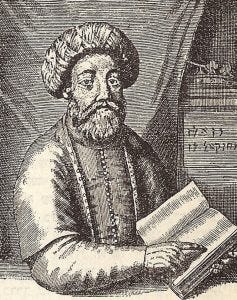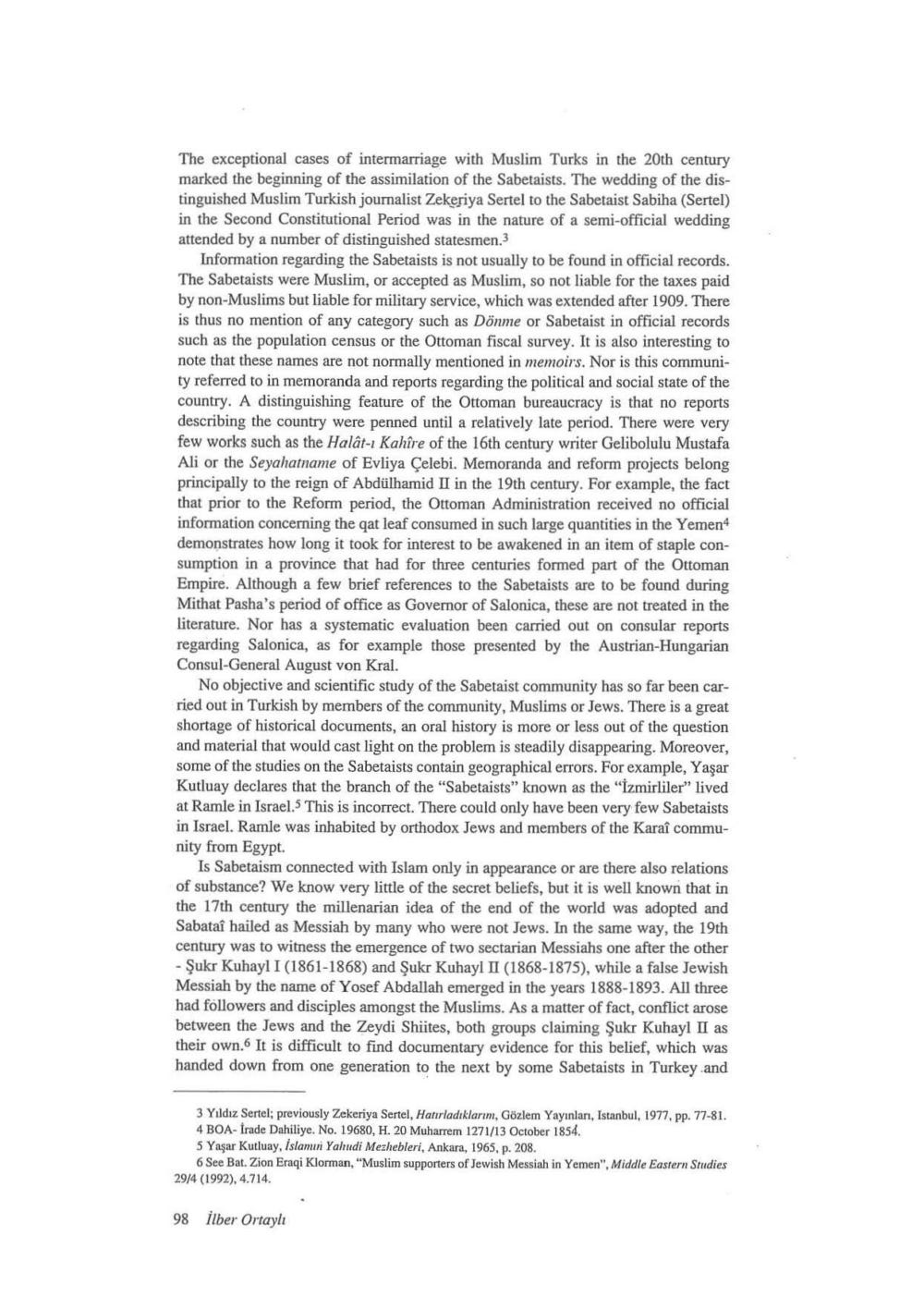Judge NOT WHAT he said, but WHAT he did!
==
https://www.jewishpress.com/news/middle-east/turkey/rumors-of-erdogans-descent-from-failed-jewish-messiah-shabtai-tzvi-may-explain-his-recent-antisemitic-outbursts/2024/05/31/
Shabbetai Tzvi by Ana sayfa
In the mid-17th century, belief in Shabbetai Tzvi spread like wildfire throughout the Jewish world, sweeping up entire communities and creating a crisis of faith unprecedented in Jewish history.
Shabbetai Tzvi was said to be born on the 9th of Av in 1626, to a wealthy family of merchants in Izmir, Turkey. He received a thorough Talmudic education and, still in his teens, was assigned as a hakham — a member of the rabbinic elite. However, Shabbetai Zevi was interested less in Talmud than in Jewish mysticism. Starting in his late teens he studied kabbalah , attracting a group of followers whom he initiated into the secrets of the mystical tradition.
In 1648, Shabbetai Tzvi declared himself to be the messiah as a result of which the rabbis banished him from his hometown, and he spent much of the 1650s traveling through Greece and Turkey. He was eventually expelled from the Jewish communities in Salonika and Istanbul as well. The turning point in his messianic career came in 1665 as the result of a meeting with Nathan of Gaza.
Nathan tried to convince Shabbetai of his messianic identity and in 1665 publicly announced the appearance of the messiah. In spite of the opposition of most rabbis, initiated a mass movement of repentance, fasting and ascetic acts to prepare the way for the coming redemption. In September 1665, he announced that a fundamental cosmic shift had taken place and that within the year, Zevi would bring back the lost tribes of Israel and marry Rebecca, the daughter of a resurrected Moses.
In the same month, Shabbetai Tzvi traveled to Izmir amidst an atmosphere of religious agitation. Rabbis and communal leaders were swept up in the excitement. With his followers, he stormed the Portuguese synagogue in Izmir that was used by his opponents, called up family members and friends — including women — to the reading of the Torah, and had them pronounce the divine name in their blessings.
Messianic enthusiasm began to spread throughout the communities of the Diaspora. Repentance, extreme asceticism, scourging, and fasting alternated with periods of ecstatic joy. Messianic prayers written by Nathan of Gaza were published. A part of the Jews began to make travel plans for their imminent departure to the Land of Israel.
Shabbateanism influenced communities all over the Jewish World and the movement took on a momentum of its own. Around the Jewish world, a split emerged between believers and their opponents.
In 1666 Shabbetai Tzvi was arrested in Constantinople and offered the choice of apostasy or death, He chose to convert to Islam. Shabbetai Tzvi became Aziz Mehmed Effendi, and, with a royal pension, lived until 1676, secretly practicing Jewish ritual. His letters reveal that at the time of his death, he still believed in his messianic mission.
While Shabbetai Tzvi’s conversion created a crisis of faith for most of his followers, the movement lived on, sustained by kabbalistic explanations for the apostasy and by its adherents.
Shabbateanism’s long-term impact was far-reaching. Its most immediate influence was in the formulation of a new version of Jewish mysticism — the Hasidic movement, born in late 18th-century Poland. The quietistic, inwardly spiritual tone of early Hasidism was a conscious reaction against the messianic excesses of the Shabbeteans, while the Hasidic Jews’ unconditional faith in their rebbe or tzaddik had as its precedent the dynamic between Shabbetai Zevi and his followers. In the late 20th century, the resurgence of messianic fervor among some Chabad-Lubavitch Hasidic Jews lent credence to this relationship.
Sabetai Zvi (Sabetay Sevi) and Sabetaism Discussions in Turkey by Ozan Örmeci
19 Ekim 2010 Salı
Sabetai Zvi[1] (1626-1676) was a Jewish ecclesiastic and Kabbalist who was born in Smyrna (İzmir) as an Ottoman Jew.[2] Zvi later enunciated himself as the long-awaited Jewish Messiah, became the founder of the Jewish-Sabetaist movement and inspired the founding of a number of other similar sects.[3] Zvi’s huge influence on the Ottoman and even on European Jews created some social problems[4] and with all its religious tolerance[5] the Ottoman State forced him and his community to convert into Islam on 16 September 1666 by the decision of Imperial Council (Divan) headed by Sultan Mehmed IV.[6] Zvi took the name of “Aziz Mehmet Efendi” and with his community he lived pretending to be a Muslim.[7] The followers of Sabetai Zvi are called Dönme, Avdeti or Sazanikos.[8]
In Ottoman official records, Sabetaists are accepted as Muslims but in fact until the 20th century Sabetaists kept their unique identity and continued to make intermarriages.[9] According to Galante, some Ottoman cities especially Salonika persisted to be Jewish-Sabetaist dominated city and after the loss of this city Sabetaist families returned to Turkish territory via migration and population exchange (mübadele) between Turkey and Greece.[10] Starting from 20th century, especially after the foundation of the Republic of Turkey, Sabetaist identity was weakened with new modern identities and norms.
However, questions around converted Jews have always existed and it became an assault mechanism for Islamists after the Kemalist Revolution and the foundation of secular Republic.[11]
Sabetaism debate has become one of the most popular and controversial topic in Turkish intellectual life in the last decade although it was only a matter of interest for Islamists two decades ago.
Sabetaism discussions gained widespread popularity after Yalçın Küçük and Soner Yalçın’s books, two controversial but popular names from leftist-socialist tradition.
Yalçın Küçük in his books Tekeliyet 1-2, Şebeke - Network and Caligula Saralı Cumhur talks about a hegemonic class of Sabetaist families in Turkey who are able to occupy all important positions in economic, political and cultural life.
Soner Yalçın’s best-seller books Efendi and Efendi 2 also contributed much to the spread of debates on Sabetaism. In his popular books, Yalçın tried to show how people from Jewish-Sabetaist background (he called them “White Turks - Beyaz Türkler”) and Sabetaist families’ sons-in-law (including former Prime Minister Adnan Menderes and Foreign Minister Fatin Rüştü Zorlu) came to critical positions in the country.
Unfortunately, as Sabetaism discussions had become popular, this search of mystery and family roots turned into conspiracy theories and a witch-hunt and people having Sabetaist background were labeled as “powerful born (iktidar doğanlar)”.[12] As it was stated by Cengiz Şişman, many prestigious people in Turkey became victims of this madness.[13]
[1] Sabetay Sevi in Turkish. For a detailed research on Zvi see; John Freely. 2002. Kayıp Mesih Sabetay Sevi’nin İzini Sürerken. İstanbul: Remzi Kitabevi.
[2] Cengiz Şişman. 2008. Sabatay Sevi ve Sabataycılar: Mitler ve Gerçekler. Ankara: Aşina Kitaplar, p. 26.
[3] ibid., pp. 26-30
[4] According to Şişman, although Zvi’s movement did not create social explosions, it disturbed some segments of the Ottoman Jewish community. For instance, İzmir’s chief rabbi Haim Benveniste complained about the division among the Jewish community among Zvi supporters and opposites. The division among Jewish community was a problem for Ottoman Palace that was implementing a proto “millet system” in these years in order to control the Ottoman society. See; Cengiz Şişman, Sabatay Sevi ve Sabataycılar: Mitler ve Gerçekler, pp. 45-47. Moreover, Zvi’s influence was even greater than his homeland in Europe since the emergence of a Jewish messiah meant the rise of an antichrist according to Christian belief. It must be also noted that the year that Zvi became famous in Europe -1666- (666 is accepted as the symbol of devil in Christianity) also increased European Jews and Christians’ curiosity about him and many Europeans came to Ottoman lands in order to see Zvi. See; Cengiz Şişman, Sabatay Sevi ve Sabataycılar: Mitler ve Gerçekler, pp. 36-37.
[5] Freely also considered Ottoman State’s approach to Zvi relatively tolerant. See; John Freely, Kayıp Mesih Sabetay Sevi’nin İzini Sürerken, p. 141.
[6] İlber Ortaylı, “Ottoman Modernisation and Sabetaism” in Tord Olsson, Elisabeth Özdalga and Catharina Randvere (ed.) Alevi Identity. Istanbul: The Economic and Social History Foundation of Turkey, p. 97.
[7] Cengiz Şişman, Sabatay Sevi ve Sabataycılar: Mitler ve Gerçekler, pp. 46-56.
[8] A type of fish that changes its color in accordance with the environment, a term blaming Sabetaists for pretending to act like a Muslim although they are not. See; İlber Ortaylı, “Ottoman Modernisation and Sabetaism”, p. 97.
[9] İlber Ortaylı, “Ottoman Modernisation and Sabetaism”, p. 98.
[10] Abraham Galante. 2000. Sabetay Sevi ve Sabetaycıların Gelenekleri. İstanbul: Zvi-Geyik Yayınları, p. 108.
[11] For a typical Islamist reaction see; Mehmet Şevket Eygi. 2000. Yahudi Türkler Yahut Sabetaycılar: İki Kimlikli, Gizli, Esrarlı ve Çok Güçlü Bir Cemaat”. İstanbul: ZVI-Geyik Yayınları.
[12] See; Tayfun Er. 2007. Erguvaniler Türkiye’de İktidar Doğanlar. İzmir: Duvar Yayınları.
[13] Cengiz Şişman, Sabatay Sevi ve Sabataycılar: Mitler ve Gerçekler, p. 16.Ozan Örmeci















Thought this might interest you my friend.
https://open.substack.com/pub/karlradl14/p/the-jewish-paedophile-network-operating?r=1k6a7g&utm_medium=ios